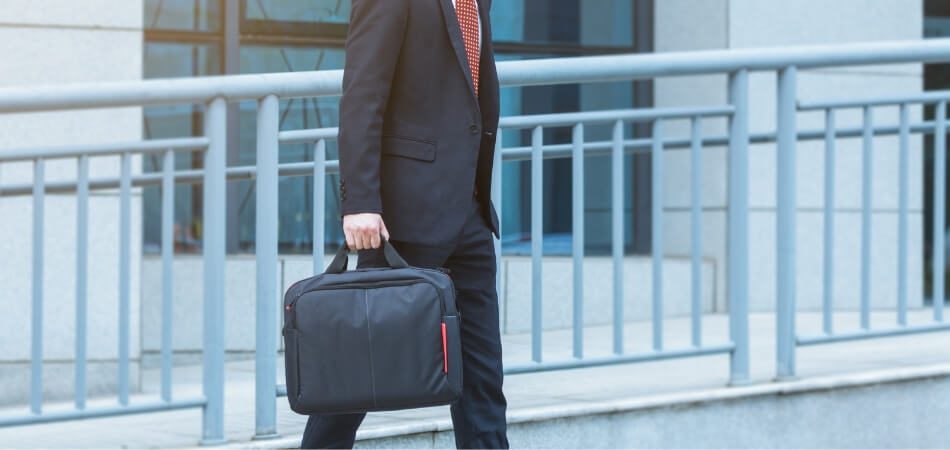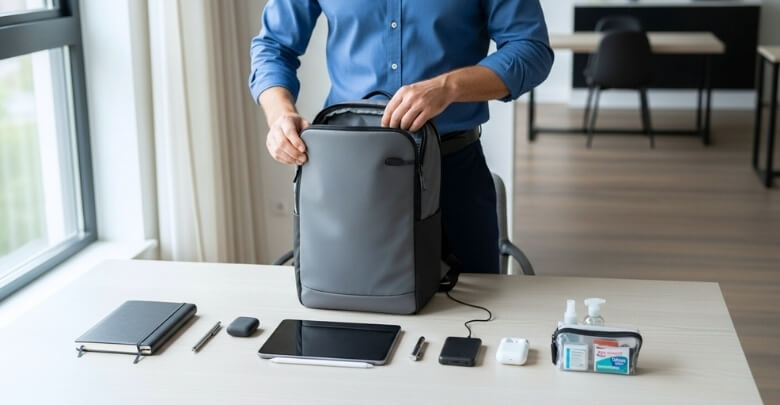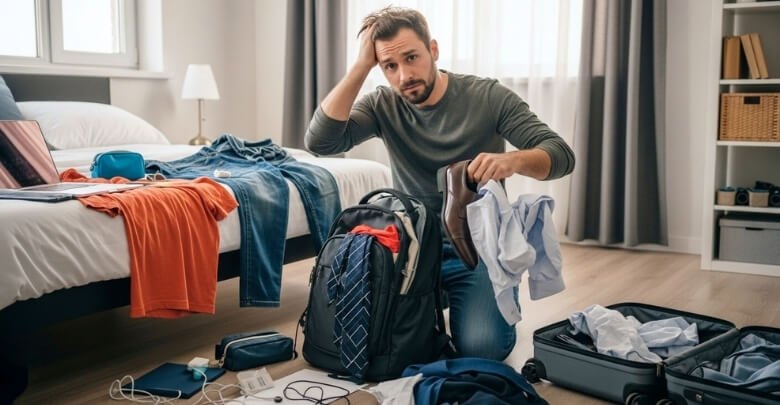Think about the last time you packed for an important event, did your bag make life easier, or did it slow you down? At a conference, the wrong bag can mean sore shoulders, lost time, or even missed networking opportunities.
What kind of bag should I bring to a conference? The best choice depends on how much you carry, your role at the event, and the venue’s rules. A medium backpack suits most people, while a messenger bag or tote can work in more formal settings.
Your bag is more than just storage; it’s part of your conference strategy. Pick wisely, and it will help you stay organized, look professional, and move with confidence. Keep reading to find the smartest options and choose the bag that fits your needs.
What Kind of Bag Should I Bring to a Conference?
Walking into a conference, the last thing you want is to feel weighed down by the wrong bag. A well-chosen bag doesn’t just carry your stuff, it makes moving between sessions easier, keeps you organized, and leaves a professional impression.

Before picking one, it helps to know the different types of bags that work best in a conference setting. Each option has its strengths, and the right choice depends on how much you carry, your role at the event, and the venue rules. These tips apply whether you’re preparing for a local meeting or attending conferences held globally, ensuring your bag always works for you. Here are the details of what bag to bring to a conference:
Backpack
A medium backpack (18–22 liters) is the most reliable choice for most attendees. It balances weight on both shoulders, leaving your hands free, while compartments keep everything tidy. It easily fits a laptop, charger, notebook, and water bottle for long conference days, making it one of the most practical choices when selecting a bag for conference use.
Messenger Bag
Messenger bags are ideal for professionals who want quick access to their laptop or notes. They rest on one shoulder, look sleek with formal outfits, and make it easy to grab essentials while standing. Just be mindful, carrying too long on one side can feel heavy.
Tote Bag
Professional totes are perfect if you want something simple yet stylish. Choose one with strong straps and a secure zip closure. It comfortably holds a tablet, notebook, personal items, and snacks. Lightweight and versatile, totes work especially well for shorter conference days.
Sling Bag
A sling bag works well for light travelers who only carry essentials like a phone, notebook, charger, and business cards. Worn across the chest or back, it offers comfort and flexibility. It’s not ideal for heavy loads, but excellent for networking-focused days.
Rolling Briefcase
If you’re traveling with tech gear or heavy documents, a rolling briefcase is a lifesaver. It eliminates shoulder strain, fits laptops, cables, and folders, and easily moves through airports. Just confirm the venue allows rolling bags since crowded spaces can be tricky.
Clear Bag (Venue-specific)
Some conferences or venues require clear bags for security. These usually have size limits like 12″ × 12″ × 6″. A clear tote or backpack keeps you compliant while holding essentials. Always check the venue’s rules ahead of time to avoid last-minute issues, as these are common for bags for conferences with large crowds.
Quick Bag Selector
| Role | Best Bag Type | Why It Works | Capacity (L) |
| General Attendee | Backpack (18–22L) | Hands-free, balanced weight, plenty of space | 18–22 |
| Speaker | Messenger Bag | Quick laptop access, professional look | 13–16 |
| Exhibitor | Rolling Briefcase | Easy to carry heavy tech & materials | 24–28 |
| Light Traveler | Tote or Sling | Simple, compact, less weight to carry | 12–16 |
| Venue Restricted | Clear Bag | Meets size/security rules | 12–15 |
Choosing the right bag is about more than looks; it’s about comfort, practicality, and confidence. Whether you go for a backpack, tote, or messenger, the right bag makes your day smoother and lets you focus fully on the conference.
Choosing a Bag That Looks Polished and Professional
When you attend a conference, your bag becomes part of your overall image. People often notice details, and carrying something neat and professional helps you stand out positively. It’s not just about convenience; it’s also about how well your style matches the setting. Let’s see what matters most.
Neutral Colors
Choosing neutral shades such as black, navy, brown, or gray instantly makes a bag look more professional. These tones blend well with suits, business casual wear, and even semi-formal outfits. Bright colors can distract and make your bag look more casual than you intend.
Sleek Design
A structured, simple design gives your bag a polished look that works in professional environments. Avoid oversized or slouchy styles, as they may appear unkempt. A clean and compact bag signals that you value organization and take your role at the conference seriously.
Zip-Top Closure
A bag with a proper closure isn’t only practical but also professional. A zip-top keeps items secure while maintaining a neat appearance. In contrast, open-top bags can look messy, and there’s always the risk of something slipping out when you’re on the move.
Your bag is more than storage; it’s part of how people see you. Picking one with the right color, design, and closure shows you care about details and professionalism, which can leave a strong impression on fellow attendees.
Venue Rules: Clear-Bag & Size Policies
When you’re preparing for a conference, one thing that can easily be overlooked is the venue’s bag policy. Some places keep it simple, while others set specific requirements that every attendee must follow. Knowing these rules ahead of time helps you avoid last-minute surprises. Let’s look closer at what these policies usually mean.
Typical Restrictions
Many large venues, especially those used for conventions, follow a clear-bag policy. A common standard is a maximum size of 12″ × 12″ × 6″ for any bag brought inside. This rule usually applies to clear totes, clear backpacks, or small handbags. Non-clear bags often must be much smaller, sometimes only allowed if they’re the size of a wallet or clutch.
Why Clear-bag Rules Exist
These rules aren’t meant to make things harder for attendees. They exist to speed up entry lines, improve safety, and make security checks more efficient. With thousands of people moving in and out during big events, clear bags allow staff to see contents quickly without digging through your belongings. This helps reduce wait times and keeps the flow smooth.
Clear-bag and size policies might feel inconvenient, but they’re there for good reason. Double-check the venue’s official guidelines before packing, so you don’t get held up at the door. A little preparation can save you time and keep your conference experience stress-free.
Essential Items for Your Conference Bag
Packing smart for a conference means focusing only on the essentials. You don’t want your bag to feel heavy or cluttered, yet you also don’t want to miss something important. A well-thought-out loadout gives you comfort and confidence all day. Here is what to bring to a conference in your bag:
Tech Gear
Tech is the heart of most conferences, and having the right gear makes life easier. A laptop or tablet for note-taking, chargers, a power bank, and earphones should always go in your bag. They’ll keep you connected, productive, and ready for sessions.
Networking Tools
Conferences thrive on connections, so bring what helps you stay memorable. Carrying conference business cards or a digital contact card is essential for networking, and a small notebook helps you capture details about the people you meet. A small notebook is handy for writing down key names and conversation details that you might otherwise forget after a busy day.
Stationery
Even with devices, stationery still matters. A notebook, pens, and sticky notes give you quick access for jotting down reminders, sketching ideas, or marking session highlights. They’re light, reliable, and a backup when tech isn’t practical or runs out of battery.
Essentials
Think about what keeps you comfortable through long sessions. A water bottle keeps you refreshed, a light snack like nuts or a granola bar maintains energy, and carrying personal medication ensures you’re prepared. These essentials keep you focused instead of distracted by discomfort.
Quick-care Kit
Small items can make a huge difference during a packed day. Sanitizer, tissues, breath mints, and travel-sized deodorant fit easily in a pouch and help you feel fresh. With these on hand, you can avoid interruptions and carry yourself with confidence all day.
Umbrella or Folding Tote
Weather and freebies often surprise conference-goers. A small umbrella keeps you dry if it rains, while a folding tote bag helps carry books, brochures, or giveaways. Both are light to pack but very practical to have when the unexpected happens.
The key to a great conference bag is balance, carrying enough to stay prepared without weighing yourself down. By focusing on these categories, you’ll have everything you need at your fingertips and enjoy the event with far less stress.
Comfort and Security Features in a Conference Bag
Carrying the right bag is only half the story; how it feels and how safe it keeps your belongings matter just as much. A comfortable and secure bag lets you focus on the conference instead of worrying about sore shoulders or missing items. Let’s break down the details you’ll want to look for.
Comfort & Ergonomics
Long days at a conference mean lots of walking, standing, and moving between sessions. Look for padded straps that reduce strain on your shoulders and back. Adjustable straps make sure the bag sits properly, while chest straps on backpacks or stabilizers on messenger bags help distribute weight evenly. These small features prevent discomfort that builds up over the day.
Security Features
With crowded halls and busy networking spaces, keeping your items safe is just as important as keeping them organized. Bags with anti-theft zippers, hidden compartments, and RFID-blocking pockets give peace of mind for valuables like your passport, phone, and credit cards. A tote with a secure zip top is also much better than an open design, since it prevents accidental spills and makes it harder for anyone to slip something out.
Comfort and security may not seem exciting, but they make a huge difference once you’re in the middle of a busy event. Choose a bag that feels good to carry and keeps your essentials safe, so you can enjoy the conference without added stress.
Helpful Tips for Using Your Conference Bag
A well-packed bag makes your day at a conference smoother, but it’s not just about what you carry; it’s about how you keep everything in order. A few small adjustments can help you stay prepared and stress-free. Here are some tips worth following.
- Dedicate an Inner Pouch for Contacts and Notes: Keep business cards, sticky notes, or a small notebook in one pouch. This way, when you meet someone new, you can exchange details quickly without shuffling through unrelated items.
- Store Chargers in a Zippered Mesh Pouch: Loose cables cause clutter. Keeping chargers, power banks, and adapters in a mesh pouch means they’re visible, organized, and ready to grab during a charging break.
- Use Small Packing Cubes or Pouches: Separate snacks, personal care items, and stationery into different pouches. This keeps your bag neat, prevents spills, and saves time when you’re looking for something in a rush.
- Do a Quick Reset Each Evening: Clear out old papers, restock business cards, and charge your devices at night. This small reset ensures your bag is fresh, tidy, and conference-ready the next morning.
- Keep a Slim Folder for Papers: Sessions often hand out brochures, schedules, or notes. A slim folder keeps these from getting crumpled in your bag and helps you review them later without a mess.
- Use a Key Clip or Leash: Many bags come with a clip for keys. Use it so you don’t waste time searching when you’re heading out of a session or back to your hotel room.
- Add a Quick-Access Pocket for Essentials: Keep items like your badge, ID, or transit card in an outer pocket. It saves you from digging through your bag when you need them quickly.
These small tips make a big difference during a busy event. By keeping your conference bag neat and practical, you’ll avoid unnecessary stress and stay focused on what really matters: learning and building connections.
Common Mistakes to Avoid With Conference Bags
Even with the best intentions, it’s easy to make a few mistakes when packing for a conference. Avoiding these small slip-ups will save you time, stress, and sore shoulders. Here are some common missteps worth steering clear of.
Overpacking With Unnecessary Items
Carrying too much makes your bag heavy and uncomfortable. Bringing extras like multiple notebooks, extra shoes, or bulky items you won’t use wastes space. Stick to essentials, so your bag feels lighter and easier to manage all day.
Choosing Flashy or Casual Bags
A bright gym backpack or oversized tote may stand out, but not in the right way. Flashy designs can clash with professional settings. Instead, pick a neutral, structured bag that matches the tone of a conference environment.
Ignoring Venue Bag Policies
Some venues only allow clear bags or limit size to 12″ × 12″ × 6″. Ignoring these rules can slow you down at entry or even keep you out. Always check policies beforehand to avoid hassles.
Carrying Heavy Paper Instead of Digital Files
Stuffing your bag with printed handouts or large binders adds unnecessary weight. Save key documents on your laptop, tablet, or phone instead. A slim folder for a few essentials is fine, but digital storage is much easier to handle.
These mistakes may seem small, but they can quickly turn your conference experience into a struggle. By sidestepping them, you’ll keep your load lighter, more professional, and better suited for the busy pace that most conference bags are expected to handle.
Frequently Asked Questions
After learning about the different types of conference bags and how to pack them, many people still have a few practical questions. Here are some that often come up and might help you feel even more prepared.
Can I Bring Two Bags to a Conference?
Yes, you can bring two bags, but it’s best to keep them small. Most attendees carry one main bag and a smaller pouch or clutch. Keeping things light makes moving between sessions easier.
Should I Choose a Bag With Wheels for a Conference?
A wheeled bag works well if you’re carrying heavy items or setting up as an exhibitor. For general attendees, it may feel bulky in crowded areas. Always check if the venue allows rolling bags indoors.
How Do I Keep My Bag From Getting Too Heavy?
Focus on the essentials and avoid carrying extras you won’t use. Choose lightweight items, refill your water bottle instead of carrying several, and use digital notes instead of multiple notebooks. This keeps your bag comfortable all day.
Are Backpacks Considered Professional Enough?
Yes, slim and structured backpacks in neutral colors look professional at conferences. They balance weight evenly and keep your hands free. Just avoid casual sports backpacks, which may look out of place in a professional environment.
What’s the Best Way to Carry Snacks Without Mess?
Keep snacks in a small zip pouch or sealed container. This prevents crumbs or spills from spreading inside your bag. Handy options include granola bars or nuts that don’t take up much space.
Can I Use the Same Bag for Work and Conferences?
Absolutely, as long as it’s versatile and professional. A well-structured tote, messenger, or backpack can easily move from daily office use to conference days. This way, you save money and always carry a familiar bag.
Should I Pack Extra Space for Conference Swag?
Yes, it’s smart to leave a little room. Conferences often hand out brochures, notebooks, or small gifts. A folding tote inside your main bag is a simple way to handle extras without carrying a bulky bag.
Concluding Words
Choosing the right bag may seem like a small detail, but it can truly shape your conference experience. Comfort, organization, and professionalism all start with having a bag that supports your day instead of slowing you down.
So, what kind of bag should I bring to a conference? The best bag for conference depends on your role, how much you need to carry, and any venue rules in place. From backpacks to messenger bags, the right option balances practicality with a polished look.
Eventually, your bag is more than just storage; it’s part of how you present yourself and how smoothly you move through the event. Pick carefully, pack smartly, and let your bag help you focus on the connections and opportunities that matter most.







